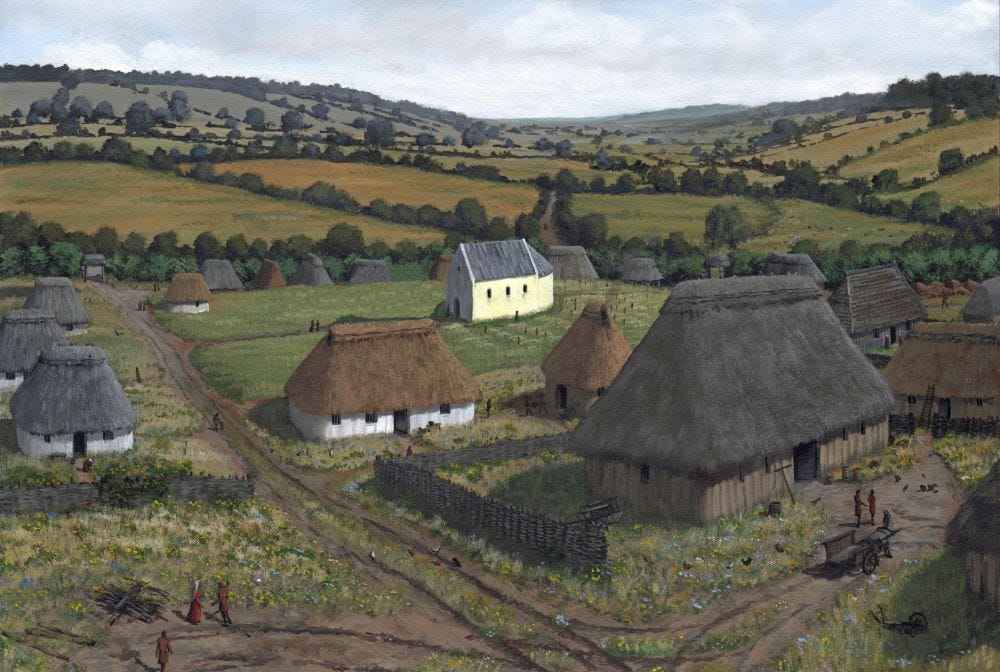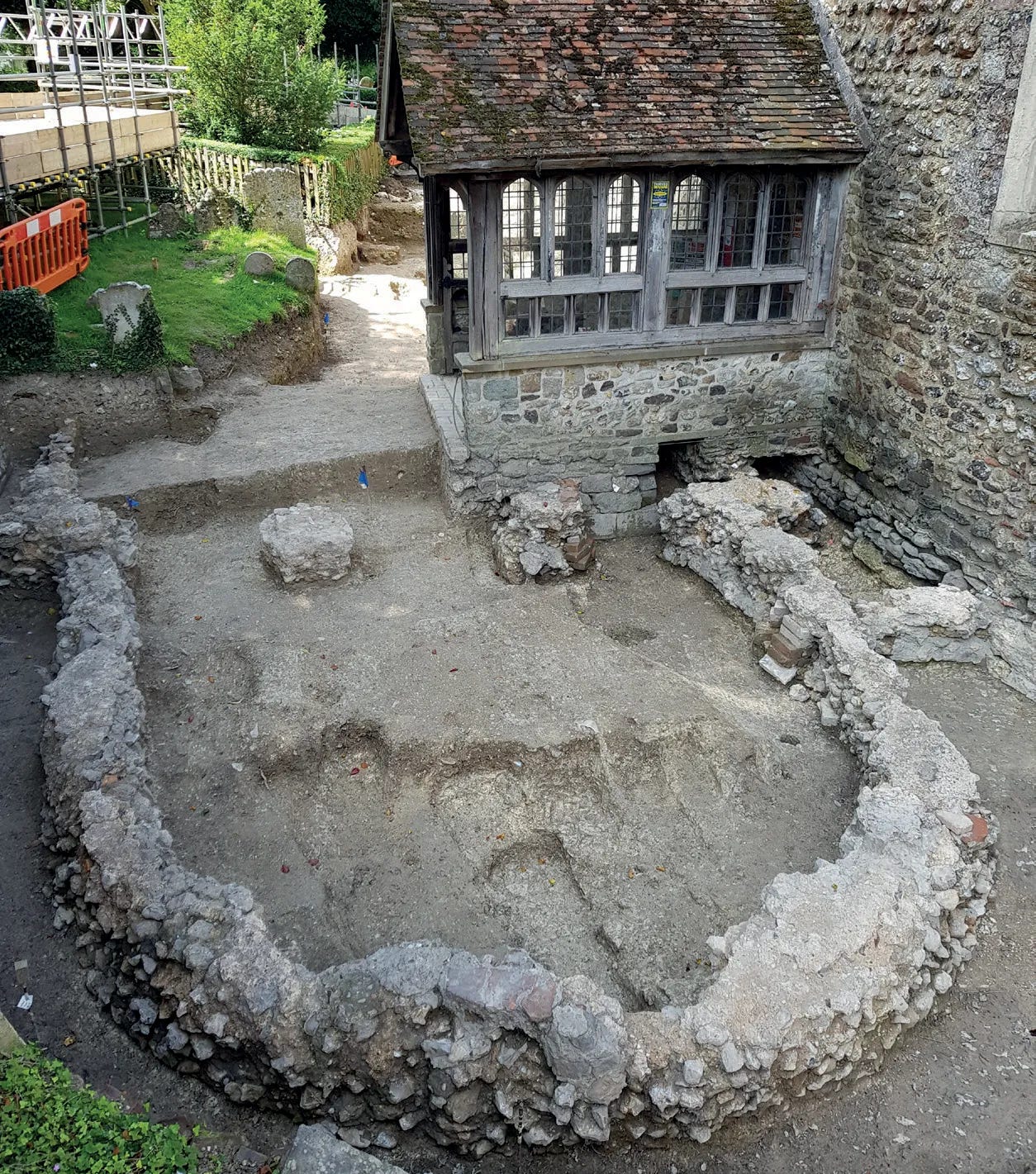Raids and relics: a monastery's fight to endure the Viking age
Turns out some monasteries could survive Viking attacks and still prosper.
Imagine living in a tranquil cloister perched on the coast. Dawn breaks over the countryside, bathing the stone buildings in golden light. You hear the soft toll of the bell echo through the halls. A solemn prayer unfolds. After a moment of eternity spent in devotion, you take an enthusiastic step toward your herb garden. Toil away, medical expertise is needed. Your thoughts briefly wander off to the manuscripts waiting in the scriptorium. The smoky candles have been waning lately, you’re thinking of beekeeping with your fellow brethren. Suddenly, you lose your train of thought altogether. Sails on the horizon. You drop your tools and rush to clutch a relic before it’s too late. A thunderous encounter is about to take place.
For a long time, the prevailing view has been that Viking raids brought monastic life in England to a near standstill: monasteries were pillaged, communities scattered, and the Church rebuilt almost from scratch under Alfred the Great. Yet, as with all things Viking, recent evidence suggests this narrative may be oversimplified. In Kent, a region that bore the full force of Viking attacks during the late 8th and early 9th centuries, the monastery at Lyminge tells a more resilient story.
According to new research by Dr. Gabor Thomas of the University of Reading, published in Archaeologia, the monastic community at Lyminge not only endured but recovered far more fully than previously believed. His findings reveal that the community persisted for nearly two centuries after its foundation in the second half of the 7th century. Far from being passive victims, monasteries like Lyminge, often located at key points along rivers and estuaries, played active roles in shaping responses to the Viking threat. This included both military measures and forms of peaceful negotiation.
The Kentish Miracle
By the time Viking sails began appearing on the horizon, Kent was no longer the dominant kingdom it had once been. In the early 7th century, under King Æthelberht, it had stood at the forefront of political and religious transformation, welcoming Augustine’s mission from Rome and shaping the early Christian landscape of England. But by the 8th century, Kent had been absorbed into the rising power of Mercia. Despite this political decline, Kent remained immensely wealthy, particularly its monastic institutions. The region’s exposed position, jutting into the North Sea, combined with its riches, made it a prime target for Viking raiders. Some of these incursions may have begun even earlier than previously thought, potentially before the 8th century.
Lyminge, one of Kent’s key monastic centres and located on the old way to Canterbury, reflects the region’s early and enduring Christian significance. According to the Kentish Royal Legend, the monastery was founded in 633 AD by Queen Aethelburga, daughter of Aethelberht of Kent. The present-day parish church in Lyminge is still dedicated to her, underscoring the site’s long-standing association with the saint.
What sets Lyminge apart is the richness of its historical record. Surviving charters attest to generous royal patronage: kings granting extensive estates and resources to the community. These documents suggest that the abbey was likely founded in the final third of the 7th century, possibly as a nunnery or a double house, in line with Frankish models where monks and nuns lived in close cooperation. Hence, Lyminge appears to have been part of a coordinated network of nunneries established under royal initiative, with communities that participated in synods together and helped to advance the influence of the Kentish dynasty. Around 800 AD, charters link Lyminge to Cynethryth, a prominent Mercian noblewoman and former queen who served as abbess of Minster-in-Thanet. Her involvement reveals Lyminge’s integration into broader networks of aristocratic power, religious authority, and political patronage in early medieval England. Most Kentish monasteries were, in fact, run by women. Their sumptuous manuscripts written in gold on parchment dyed purple are amongst the finest produced anywhere in Western Europe. Such cloisters were powerhouses not only of prayer, but also of culture and luxury goods – no wonder Vikings were dead set on pillaging them.

In the late 11th century, the hagiographer Goscelin of St-Bertin described the translation of relics from Lyminge to St Gregory’s Priory in Canterbury, an event that took place in 1085. His account suggests that Lyminge housed more than just the relics of Queen Aethelburga, who was also the second wife of King Edwin of Northumbria. This opens the possibility that the abbey’s principal saint may, in fact, have been Eadburg, possibly the same Eadburg who succeeded Mildreth as abbess of Minster-in-Thanet. While the precise identity of Lyminge’s primary saint remains uncertain, the existence of multiple relics and their formal translation to Canterbury underscores Lyminge’s importance within the spiritual and ecclesiastical landscape of early English Christianity.
However, it is important not to project later medieval expectations onto these early monastic sites. Lyminge was not a tightly bound cloistered complex specific to the High Middle Ages but rather a more diffuse monastic landscape. The community would have occupied a large area, marked by multiple focal points, dispersed cemeteries, and atomised communal buildings. At its heart stood a stone-built church dating to the 7th century, but surrounding it were zones of agricultural and industrial activity that extended across several acres. The monastery was a hub of production, trade, and local economy.
Inside the church, one might have found the portable wealth we associate with early ecclesiastical life: elaborately decorated chalices, crosses, textiles, and tapestries. Yet, contrary to older assumptions, widespread destruction and total abandonment in the face of Viking incursions were not the norm. True, a few sites such as Whithorn and Portmahomack show strong archaeological evidence of violent attack, like smashed sculptures, fire damage, and human remains with signs of trauma, but these appear to be exceptions rather than the rule.
Survival and decline
At Lyminge, extensive excavations and carbon dating have produced a nuanced chronology. Rather than sudden collapse, we see evidence of a gradual shift in settlement patterns, with occupation moving to new locations in the landscape over time. Although dating southern English sites remains difficult due to sparse coinage compared to regions like East Anglia or Northumbria, and pottery that only offers date ranges of 100 to 150 years, carbon dating has been instrumental. It reveals that life at Lyminge continued well beyond 804 AD. Domestic debris, structures, and signs of wealth all point to an ongoing, adaptive community. The Norse did not wipe out these sturdy nuns.
The charter of 804 adds further detail, documenting that a refuge in Canterbury had been granted to the Lyminge community. This suggests an organised, pragmatic response to the dangers of the period, most likely Norse piracy, and supports the idea that early monastic communities actively sought ways to endure rather than simply vanish. Further insights into the pressures faced by Kentish monastic communities during the Viking Age come from charters issued under Mercian authority in this period. These documents reveal that monasteries were stripped of their traditional immunities, such as exemption from military service and obligations to maintain bridges and fortifications. Instead, their assets and labour were redirected into regional defensive strategies against the Viking threat.
Extensive excavations at Lyminge, covering nearly two acres, have enabled archaeologists to construct a detailed chronological framework using radiocarbon dating, coinage, and artefactual evidence. This data has allowed a meaningful dialogue between archaeological findings and written sources, shedding light on long-term shifts in settlement patterns across the ninth century and beyond. The site's development can be traced through several key phases. The Middle Saxon focus (5th–7th centuries AD) was concentrated around a natural spring: a common marker of sacred or communal use. Excavations revealed significant occupation during this phase, including a large timber structure interpreted as a threshing barn, which may have been funded through Mercian investment.
In the Late Saxon transition, radiocarbon dating places the end of monastic activity at Lyminge between 835 and 1120 AD, with the most likely decline occurring before the late ninth century. This period corresponds with intensified Viking activity in Kent, particularly during the 880s and 890s, hinting at a possible causal link. The evidence points to a noticeable decline in visible wealth and economic output, alongside a reorganisation of monastic roles and spatial arrangements. However, the site was not obliterated. In the Norman period, following a likely hiatus, settlement resumed, likely as part of renewed ecclesiastical investment in Lyminge during the early tenth century. Thus, by the late 9th century, occupation at the original site ceased, but life was re-established nearby. According to the report, the mid-9th century represents a pivotal moment in Lyminge’s history, marked by clear transformations in monastic life and local economy. Yet this was not a story of abrupt collapse. Lyminge might seem like a long-lasting early medieval site, but its story is even more dynamic - over the centuries, the settlement shifted around, with changes not just in location but also in how each area was laid out and used.
This pattern of adaptation rather than annihilation can be observed at other sites as well. For example, Repton suffered destruction in the 8th century, was later occupied by Viking forces, yet continued to function as a burial site. Similarly, Lyminge, though ultimately abandoned in the context of political conquest during the Viking presence in the 880s, was not destroyed from the outset. Evidence from Kent at this time points not only to raids, but to prolonged occupation: the Vikings overwintered in places like Sheppey and exerted control over political centres such as Canterbury.
In short, Lyminge’s story is one of disruption, resilience, and renewal. While the community faced intense pressures from Viking activity, it adapted, shifted location, and ultimately endured, leaving behind a rich material legacy that speaks to the persistence of early English monasticism during one of its most turbulent eras. The same pattern appears across Kent. Rather than senseless destruction, what we often see is selective targeting and strategic exploitation. For instance, Lyminge’s stone church remained standing until the Normans built the later parish church. The Vikings weren’t driven by religious hatred, they were just being practical. They recognised the wealth and productivity of these communities. In a way, they acted parasitically: attacking, yes, but also leaving room for these places to survive, because that meant more opportunities to exploit them later.
So, contrary to the popular image of helpless monks and burned-out cloisters, the community at Lyminge was far from passive. They responded with foresight and flexibility, surviving nearly two centuries after their founding. This kind of research urges us to rethink the Viking Age not as a time of straightforward destruction, but of transformation. Amid the violence, there were continuities in faith, in structure, in life itself.






